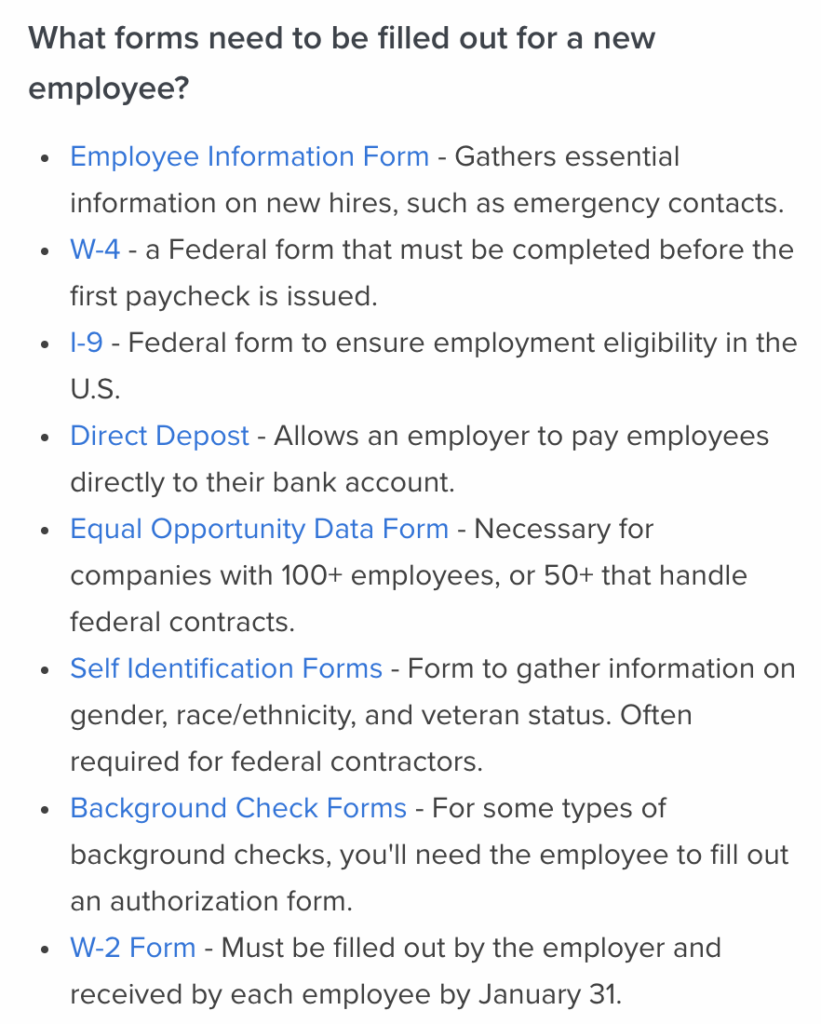You’ve just spent weeks, maybe even months, recruiting and interviewing job prospects.
You finally make a choice––a candidate who fits your needs and culture almost perfectly. They accept your offer and come on board.
But then, not even two months later, they quit. You’re back to square one and all that time and money spent hiring is thrown out the window.
Unfortunately, this happens more often than you might think.
In fact, 20% of employees have left a job within the first 45 days.
New hire turnover can happen for a number of reasons. An individual may enter a job to find it doesn’t fit their needs or expectations, or a toxic work culture might drive new hires away.
However, one of the biggest factors that can contribute to new hire turnover is a lack of onboarding structure.
The first few weeks a new employee is in the office can be crucial. It’s during that time that the individual should start to find their groove and become confident in the job they’re doing. If there aren’t adequate processes in place, your new employee may start to think twice about their decision and decide the opportunity isn’t right for them.
But what can you do to ensure a new hire gets off on the right foot? We’ve compiled a new hire checklist.
Your new hire checklist
- Before the first day
- ⬚ 1. Send and complete new hire paperwork.
- ⬚ 2. Get their equipment ready.
- ⬚ 3. Inform them of company policies.
- On the first day
- ⬚ 4. Give them a tour.
- ⬚ 5. Hold introductory meetings with teams and managers.
- ⬚ 6. Set job expectations.
- The first week
- ⬚ 7. Work through a training plan.
- ⬚ 8. Assign their first tasks.
- The first month
- ⬚ 9. Go over employee progress.
- ⬚ 10. Ask for feedback.
Like what you see?
Don’t miss out. Subscribe to our monthly digest to get the latest TA and TM resources delivered right to your inbox.
Before the first day.
Take advantage of the time between finalizing a contract with a new employee and their first day.
Here’s what you need to complete before day one.
1. Send and complete new hire paperwork.
Onboarding a new employee usually involves a lot of paperwork. From payment forms to emergency contact sheets, your new hire will need to share a lot of information.
You can make the process go smoother by sending the necessary paperwork to your new hire before their first day. This will give them time to fill everything out or gather the information that they need.
This way, when they finally start in the office, they’ll be all set to get started.
You should also opt for digital documents. Sending and signing digital documents can create even more efficiency, so your new employee can hit the ground running on their first day.

Check carefully which forms and documents your new hire has to fill in and instruct them on how to complete the paperwork.
2. Get their equipment ready.
Depending on the job you’re hiring for, you’ll likely need to order or purchase certain equipment or supplies. This could include everything from new machinery, a laptop, a uniform, or even something as small as name tags, pens and a notebook.
Make sure any necessary orders are placed well before your new employee starts. If you already have the equipment, double-check that everything is working properly.
Pre-install whatever software your employee will need and make sure all their accounts are properly set up.
You don’t want your new employee to come in for their first day only to find they can’t actually do anything. Having their equipment and supplies ready and waiting for them can allow for a smoother ride.
3. Inform them of company policies.
The first day on the job can be stressful regardless of how much you know about the organization, but if a new hire is going in with no idea of what to expect, the day can feel even more overwhelming.
Make sure your new employee is familiar with company policies, benefits, or even little cultural expectations before they come in.
Before they get started, let them know:
- your health insurance plans, pension and other benefits
- what hours they’re expected to work (or if you have a flexible hour policy)
- what your dress code is.
Other important policies include:
- breaks
- time off
- cost reimbursement
- and even lunch.
Try and think of what you’d like to know if you were just starting at the company––even if it isn’t a direct company policy. If your office has any quirks or routines that a new hire should know about, fill them in so they feel more welcome on their first day.
If you have an employee handbook, share it with your new employees and make sure they always have access to the latest version. It will allow your new hires to always have all the necessary information at hand.

52%
of employees state that receiving organized, relevant and well-time content would make the onboarding process more helpful to new hires.
Source: BambooHR
Providing your new hires with relevant content during the onboarding phase will help them settle into the new role more easily.
On the first day.
The first day is always going to be overwhelming, but it’s your job to make it a little more palatable for new hires.
Here are some things your team should do to ensure a smooth onboarding process for your new employee from day one.
4. Give them a tour.
The last thing you want is your new hire wondering where the bathrooms are.
As soon as your new hire arrives, give them a tour of your space. Show them where their desk will be, as well as walk them through communal or important spaces, such as:
- the kitchen
- phone booths
- conference rooms.
If your office building requires access through a fingerprint, card pass, or key fob, make sure they’re all set up and their entry works. If your office building only requires a traditional key, make sure to have a copy ready for your new hire.
Let them know any evacuation plans, including where the stairs are in case of a fire.
How AI & recruitment technology is changing recruiting experience
Find out how tech has helped other companies grow by enhancing both the recruiters’ and candidates’ experience!
5. Hold introductory meetings with teams and managers.
Introduce your new hire to any teams they’ll be working with or important people they’ll need to become familiar with.
First, hold a meeting with HR. This will allow your new employee to ask any questions about policies, benefits, or the office in general and help prevent any confusion. It can also give your team time to ensure all the appropriate paperwork is filled out and filed.
If possible, hold a meeting with the CEO or other C-suite executives that the new hire may come in contact with. For example, a new marketing employee should have an opportunity to sit down with the Chief Marketing Executive.
The new hire should also have a one-on-one meeting with their supervisor. This will allow each side to establish expectations, talk about what they’d like to accomplish and ask questions related to the specific work the new employee has been hired to complete.
Finally, hold a meeting with the new hire’s team members, including interns. Try and make this meeting a good bonding opportunity so the new hire can become familiar with the people they will be working with every day. This could be a lunch or a morning coffee.

72%
of new hires say 1-on-1 time with their direct manager is the most important during onboarding.
Source: Linkedin
Instead of spending their first days with HR, give your new hires an opportunity to bond with their manager – they will appreciate it.
6. Set job expectations.
It may seem like a lot to set job expectations on the very first day. However, going through goals, key performance indicators, and job responsibilities can set your new hire off on the right foot from the very beginning.
Start by outlining what your company’s overall objectives include. Then show how the new hire’s department and individual role play a part in those goals. This can give your employee a sense of purpose at the company.
View this conversation as a two-way street.
As you set your expectations for the job, give your new hire an opportunity to discuss their own expectations. Listen to what they’d like to accomplish in the role and how that plays into their long-term career path.
Ask your new hire what you can do to make their transition into the role easier.
Now that your new hire is a part of the team, you want them to feel welcome. Work with them to adjust and refine the role to fit both your needs and look for opportunities to support your new hire during their adjustment period.
The first week.
The first week will be very busy for your new employee––but that’s a good thing. While it can feel slightly overwhelming to find their footing, keeping your new employees busy can help them stay engaged.
Here’s how you can help your new hire adjust during their first week.
7. Work through a training plan.
Your new hire probably isn’t going to be trained in a day. However, you want to have a set plan to help your new employee get up to speed.
Use your first week to walk your new hire through the training plan you’ve established.
While it can be beneficial to have a go-to training plan you use for all employees, you should still look for ways to tailor training to individual employee needs.
For example, if your new hire does not have any experience in the systems or apps you use, you might need to spend a bit more time helping them discover all the ins and outs. On the other hand, senior employees with ample experience may breeze through training without much additional attention.
Your training plan may also include some general training unique to your company. Space these programs out throughout the week so your new hire doesn’t become overwhelmed.

76%
of employees consider on-the-job training the most important in the first week.
Source: BambooHR
While reviewing company policies and getting a company tour is undeniably essential, it is the training that the new hires consider the most important in their first week.
8. Assign their first tasks.
The first week on the new job shouldn’t be all meetings and pieces of training. You want to give your new hire something to do, so be sure to assign them with their first few tasks.
However, you don’t want to throw everything at them at once.
Start slow. Assign one or two pieces of a project at a time and double-check that your new hire knows what they’re supposed to do and how it should be done. Let them know who they can report to if they have any questions.
The first week or so can feel a bit like hand-holding, but that’s okay. Making sure your new employee is well adjusted and understands their responsibilities is important for ensuring they’re happy in their new role.
The first month and beyond.
Some companies only focus on new employees during their first few days or weeks. Unfortunately, because the new hire is still adjusting during this time, it can be hard for them to truly get a feel for what they’re doing.
Your new hire checklist should continue on beyond the first month. Here are some things you should be doing after your new hire has been on the job for more than 30 days.
9. Go over employee progress.
When starting at a new company, employees may feel unsure of themselves and the work they’re doing. If they’re not getting any feedback, it can be difficult to know if they’re reaching expectations.
Have a progress meeting after your new hire has been on the job for at least a month. Use milestones and expectations you talked about on the first day or during the first week to measure success.
Talk about areas where the employee may be able to improve and ask for areas where they may need some additional help.
At this time, you’ll also want to set new milestones and goals for your employee. These kinds of constant check-ins can help the employee better understand how they’re doing in the job and what you are expecting from them.

98%
of employees will fail to be engaged when they receive little to no feedback from their managers.
Source: Officevibe
You don’t want to encourage employee disengagement right at the start, or at any time. That’s why you should make sure there is an open communication line between the new hires and their managers.
10. Ask for feedback.
The check-in process shouldn’t be a one-way conversation. You should also use this as an opportunity to gather feedback from your new hire.
Ask for their opinion on the onboarding process and whether or not everything was clear to them. See if they have any ideas or advice on how the process could be better, or if there are any areas you’ve forgotten completely.
You should also discuss how they’re fitting into their new team and if they’re enjoying their work. See if there are any opportunities to improve the culture of your company or if they believe you could be doing anything better.
Be sure to listen to their criticisms and feedback. After all, showing your new hires that they’re an important part of your team can reduce turnover, increase engagement and keep new hires in their roles longer.
Conclusion
Following this new hire checklist can ensure you don’t forget any steps when onboarding a new employee. A great onboarding experience can create engaged, productive employees who want to stick around at your organization.
Remember, onboarding isn’t a one-day process. In fact, it can take up to a year before new hires truly become as strong as their more tenured colleagues. Having a solid onboarding process in place is just the start.
How AI & recruitment technology is changing recruiting experience
Find out how tech has helped other companies grow by enhancing both the recruiters’ and candidates’ experience!


